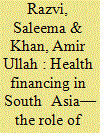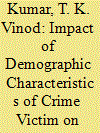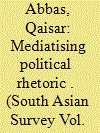|
|
|
Sort Order |
|
|
|
Items / Page
|
|
|
|
|
|
|
| Srl | Item |
| 1 |
ID:
155178


|
|
|
|
|
| Summary/Abstract |
Territorial conflicts have been among the most important fallouts of the modern
nation states, with the states advancing different kinds of justifications to claim
the territory in conflict. These justifications play an important role in shaping the
actions of the states and the solutions thereof. The states propound their claims
on ethnic, strategic, geographic proximity, economic and religious considerations.
As a result, there is an acute need to study the territory in conflict, not in terms of
objective attributes but as outcome of a dynamic relationship that exists between
an area, social processes and ideologies that give it meaning. This dynamic relationship
is visible in the territorial justifications that Pakistan has raised over Kashmir.
The justifications put forward by Pakistan are not grounded in a particular claim
like the two-nation theory, but they have varied with time to hide underlying economic,
geostrategic and other related motives in changing global and domestic
context. Shifting the claims from religious to strategic or economic basis affects the
nature of the solutions envisioned. The solutions in context of changing claims go
beyond Pakistan’s officially held position of United Nations sponsored plebiscite.
|
|
|
|
|
|
|
|
|
|
|
|
|
|
|
|
| 2 |
ID:
155173


|
|
|
|
|
| Summary/Abstract |
Small firms are at a disadvantage compared to large firms because of their size. Yet they play a very significant role in the growth of economy. These firms have little tangible assets at an early stage, but some of them have long-term growth potential. There is enough literature about individual entrepreneur, but relatively little is known about firm-level entrepreneurship, that is, entrepreneurial orientation (EO). EO consists of five dimensions: innovativeness, risk taking, proactiveness, autonomy and competitive aggressiveness. This study reviews the existing literature on the influence of EO on the growth of small firms. It tries to figure out whether this growth comes out as a demonstration of all the dimensions of EO together or a combination of them. There is an important gap in the literature on this issue, and this study focuses on this gap.
|
|
|
|
|
|
|
|
|
|
|
|
|
|
|
|
| 3 |
ID:
155174


|
|
|
|
|
| Summary/Abstract |
Millions of households are pushed into poverty every year because of high outof-pocket
(OOP) expenditure on health care. Globally, each year more than 150
million people face financial catastrophe and around 100 million suffer destitution
due to OOP payments made for health care. More than 90 per cent of these people
reside in low-income countries. In South Asia, impoverishment due to health
payments is significant with at least 32 million people in India alone being pushed
into poverty annually due to OOP expenditures on health care. In most health care
systems in this region, the role of public spending on health and prepaid schemes,
such as tax and social insurance, is limited as is the extent of financial risk protection.
The problem is compounded by the large informal sector which is a major
challenge to attaining universal health coverage in South Asian countries.
Recent literature points to the role of public–private partnerships (PPP) in
health care as a viable solution for ensuring equitable access to health care especially
for the poor. This article seeks to review the major components of health
care financing and reform including financial risk protection, resource generation
and pooling, and PPPs in procurement and payment in South Asia. It identifies
key lessons across the health financing systems of Asian countries that
have attempted to reduce dependence on OOP expenditures, expanded health
service delivery and increased pooled health financing mechanisms. It analyses
the role and importance of PPPs in mitigating the impoverishing effects of OOP
health expenditure in South Asia.
|
|
|
|
|
|
|
|
|
|
|
|
|
|
|
|
| 4 |
ID:
155176


|
|
|
|
|
| Summary/Abstract |
Demographic characteristics of crime victims have an impact on their interaction
with the police. The initial mindset of the victim before contact with the police
and post interaction assessment of satisfaction with police services are important
indicators of the social dynamics and functioning of the criminal justice system.
The first indicating individual perception of social location and accessibility to
police, and the latter the levels of professionalism in police response to victims
of crime. This study examines the influence of demographic characteristics on
the state of mind of victims when they approach police in India and further on
their assessment of police after the interaction, and on the basis of the findings
comments on the state of police services in India.
|
|
|
|
|
|
|
|
|
|
|
|
|
|
|
|
| 5 |
ID:
155175


|
|
|
|
|
| Summary/Abstract |
The mediatisation of politics has been a dominant theory in the field of political
communication for some time, proposing that the mass media in democratic
societies tend to dominate the political process. This research intends to explore
the media-politics nexus as part of the protest campaign in 2014 in Pakistan,
also known as the long march. Specifically, it analyses dynamics of the political
rhetoric of protesting leaders and dimensions of the two selected TV talk shows.
Using textual analysis as research methodology, this article concludes that by
transforming the political theatre into a media theatre, the talk shows effectively
mediatised the long march. TV news became part of the political process, rather
than covering it objectively, either by supporting or opposing the long march.
The two top political leaders of the long march voluntarily adopted media logic
as a rhetorical strategy to offer a readymade product for media coverage.
|
|
|
|
|
|
|
|
|
|
|
|
|
|
|
|
| 6 |
ID:
155177


|
|
|
|
|
| Summary/Abstract |
The South Asian Association for Regional Cooperation (SAARC) region is
bestowed with geographical, historical and cultural continuity and yet it remains
one of the least integrated regions of the world. This article attempts to analyse
the factors inhibiting the economic integration of the region. The intra-SAARC
trade is analysed in view of the existence of a free trade agreement between the
member nations. The socio-development, infrastructural and economic indicators
of the nations are also compared. The reasons for the existence of mistrust
and hostility between the SAARC countries are discussed, from India’s
evident dominant position in the group as a cause for insecurity among other
members to the political standoffs between the member nations. While there
exists immense potential for greater economic integration and gains from trade,
the lack of basic transport-transit connectivity, technical harmonisation and nontariff
barriers are found to reinforce trade costs and inhibit legal trade. Ensuring
better connectivity is recognised as a prerequisite by the nations unanimously;
however, their political differences have kept them away from making much
headway in this regard.
|
|
|
|
|
|
|
|
|
|
|
|
|
|
|
|
|
|
|
|
|